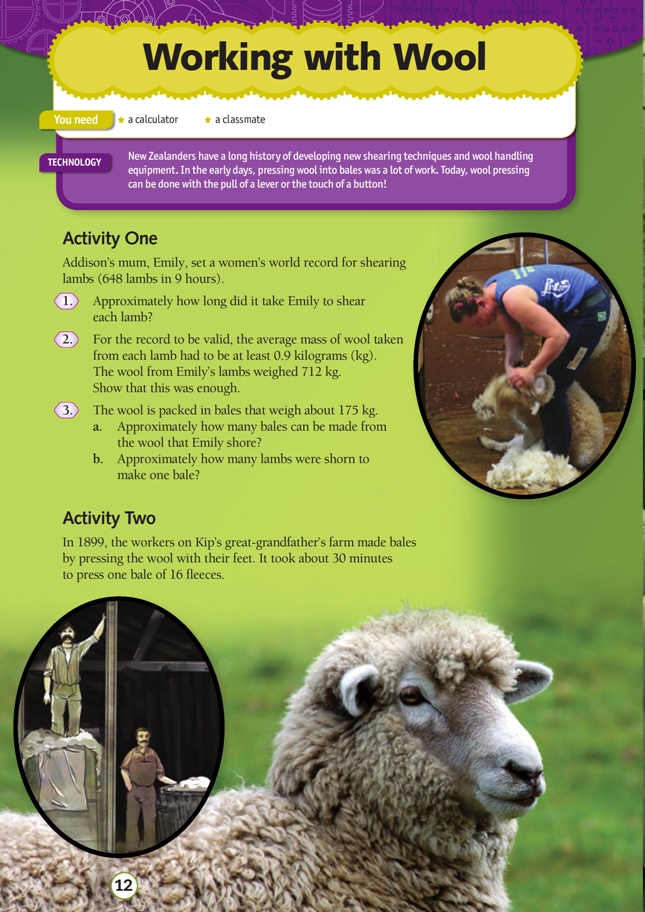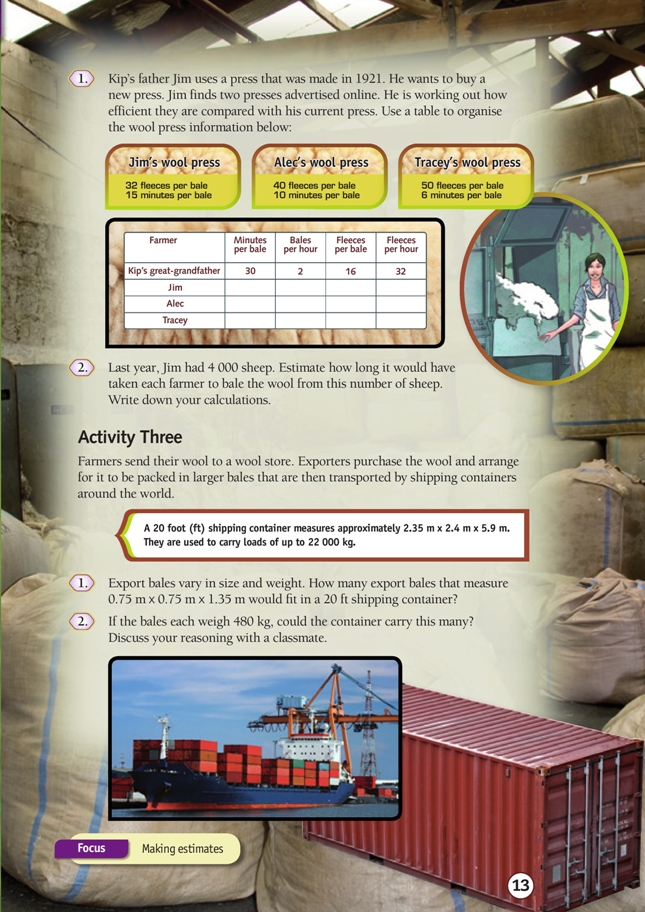This is a level 4 activity from the Figure It Out series.
A PDF of the student activity is included.
Click on the image to enlarge it. Click again to close. Download PDF (945 KB)
Mathematics in real life is not always tidy, and sometimes an estimate makes more sense than a precise calculation. Being able to make a sensible estimate is a useful everyday skill. Estimating also allows students to check whether their answers to mathematical problems are likely to be correct.
Estimating requires a good feel for the number system. In these activities, students explore the effi ciency of different wool presses by making sensible estimates.
a calculator
a classmate
Students should complete activities 1 and 2 without using a calculator. Estimating is very different from guessing. It involves making a calculation using known facts and/or relationships. Estimating strategies require good number sense and a sound understanding of the base 10 number system.
There are often several ways to reach an estimate and each way is likely to yield a somewhat different estimate. Students need to feel confident about using an approach that is different to those used by their classmates. Ask students to share their methods so that they are exposed to different approaches.
In Activity One, students are asked to estimate how long each lamb took if Emily sheared 648 lambs in 9 hours. An approximate answer is reasonable because the time to shear each lamb would vary depending on the weight of its wool, its temperament, and Emily’s energy levels. To work out how many lambs were sheared each hour, you could use 630 as an approximate number of sheep because 630 can be easily divided by 9. 630 ÷ 9 means that there were around 70 sheep per hour. There are 60 minutes in an hour, so if each sheep took a minute to shear, there would have been 60 sheep. Emily sheared more than this, so the estimate might be about 50 seconds per sheep.
Many students will be unfamiliar with long shearing competitions. Estimating how long it took Emily to shear each lamb helps to show the enormity of Emily’s feat; shearing a lamb every minute for 9 consecutive hours is easier to conceptualise than 648 lambs in 9 hours.
In question 2, the students are asked whether the wool Emily sheared met the weight requirement for the record. Students don’t need to use a calculator to work this out. If the wool mass from 648 lambs weighed 712 kg, then the average mass of the fleeces was more than 1 kg, which is more than the 0.9 kg required.
Activity Two
This activity requires students to use proportional reasoning to make estimates. Ask the students to share the strategies that they used; have a class discussion about their usefulness. Sharing strategies develops the key competency participating and contributing.
Note the use of proportional reasoning throughout: if you multiply the number of fleeces by 4, the number of hours also needs to be multiplied by 4.
Activity Three
The bales can be stacked 3 high, 3 across, and 4 deep. Students could draw a 3D-sketch of the container and use it to work out how many bales fi t across each edge. Note that calculating the volume of the shipping container and then dividing it by the volume of one bale is not an appropriate method because the bales are not a perfect fi t.
Technology-related student activities
- Research the benefits of wool. See www.campaignforwool.co.nz/technical-and-information for a wealth of related information.
- Research other ways that technology is used in New Zealand agriculture, for example, aerial top-dressing.
- Investigate agricultural inventions by looking at New Zealand Field Day websites.
- Investigate simple hydraulic and pneumatic systems that use balloons or syringes and plastic tubing. See whether you can make an object move by pushing air or water through a tube. Where are these types of systems used? (See www.ehow.com/list_6639308_school-projects-hydraulics.html)
- Debate the advantages and disadvantages of a particular agricultural technology. For example, aerial top-dressing helps a farmer to kill weeds but could be a nuisance (noise and spray-drift) for neighbouring farms.
Exploring the technology-related context
Shipping containers are an efficient way to transport goods. Their standardised dimensions allow them to be easily stacked and then transferred from ships to rail and semi-trailer trucks. Containerisation has played an important role in the development of international trade.
Answers
Activity One
1. Using estimation, a sensible answer would be about 50 seconds (s). For example, 9 hrs = 9 x 60 min = 540 min. Emily sheared 648 lambs. If she had sheared 1 lamb per min, she would only have sheared 540. If she had sheared 2 per min (30 s each) she would have sheared 1080. This shows that the approximate time is closer to 1 min than to 30 s.
2. The wool Emily sheared weighed 712 kg. She sheared 648 lambs. This means that, on average, the wool from each lamb was more than 1 kg.
3. a. 4. The wool weighed 712 kg. 712 ÷ 175 = 4.07 bales. (The bales aren’t an exact weight, so it makes sense to round down to 4.)
b. About 160 lambs. 648 lambs ÷ 4 bales = 162. (You could also divide 175 kg by the average weight of one fleece. 175 kg ÷ 1.1 kg = 159 lambs.)
Activity Two
1.
| Press Owner | Min per bale | Bales per hour | Fleeces per bale | Fleeces per hour |
| Kip’s great-grandfather | 30 | 2 | 16 | 32 |
| Jim | 15 | 4 | 32 | 128 |
| Alec | 10 | 6 | 40 | 240 |
| Tracey | 6 | 10 | 50 | 500 |
2. There are lots of ways to make an estimate. Here are some examples:
Kip’s great-grandfather’s press could bale 32 fleeces per hr. Using 30 as a “friendly number”, the amount of time it would take to bale the wool from 4 000 sheep is:
30 x 100 hrs = 3 000 sheep, 30 x 30 hrs = 900 sheep, 30 x 3 = 90 sheep
100 + 30 + 3 = 133 hrs to do 3 990 sheep, so 134 hrs is a sensible estimate for 4 000 sheep.
Jim’s press: 128 per hr, so use 125 as a friendly number
125 in 1 hr → 250 in 2 hrs → 500 in 4 hrs → 1 000 in 8 hrs → 4 000 in 32 hrs
Alec’s press: 240 per hr, so use 250 as a friendly number 250 in 1 hr → 500 in 2 hrs → 1 000 in 4 hrs → 4 000 in 16 hrs
Tracey’s press: 500 per hr 500 in 1 hr → 1 000 in 2 hrs → 4 000 in 8 hrs
Activity Three
1. 36 bales. (2.35 ÷ 0.75 = 3.13, so 3 bales across. 2.4 ÷ 0.75 = 3.2, so 3 bales high. 5.9 ÷ 1.35 = 4.4, so 4 bales deep. 3 x 3 x 4 = 36)
2. Yes. 36 bales weigh only 17 280 kg, and a shipping container can hold about 22 000 kg.

